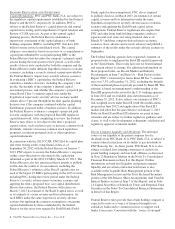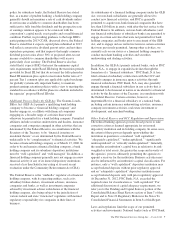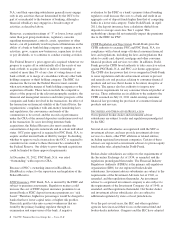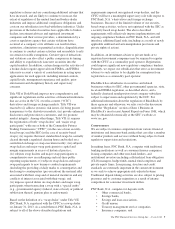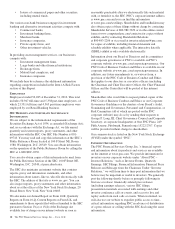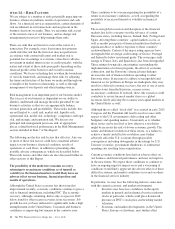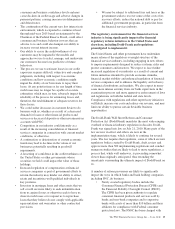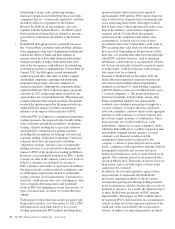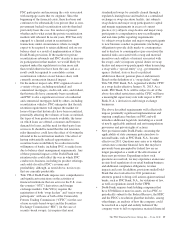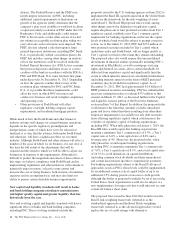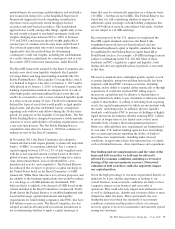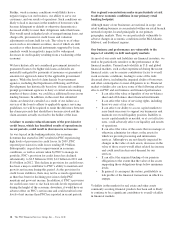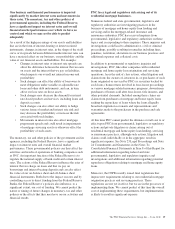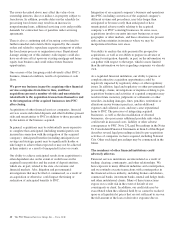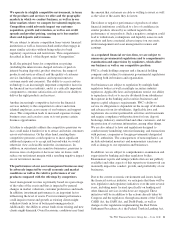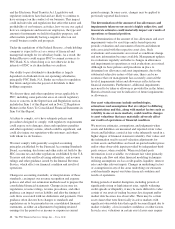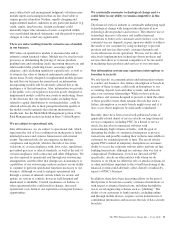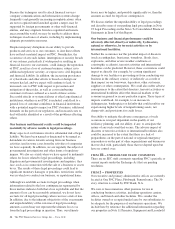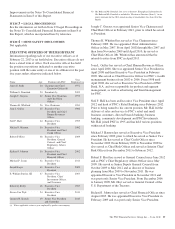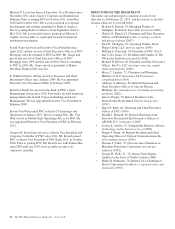PNC Bank 2012 Annual Report Download - page 35
Download and view the complete annual report
Please find page 35 of the 2012 PNC Bank annual report below. You can navigate through the pages in the report by either clicking on the pages listed below, or by using the keyword search tool below to find specific information within the annual report.distress. The Federal Reserve and the FDIC may
jointly impose restrictions on PNC, including
additional capital requirements or limitations on
growth, if the agencies jointly determine that the
company’s plan is not credible or would not facilitate
a rapid and orderly resolution of PNC under the U.S.
Bankruptcy Code, and additionally could require
PNC to divest assets or take other actions if we did
not submit an acceptable resolution plan within two
years after any such restrictions were imposed. The
FDIC also has adopted a rule that requires large
insured depository institutions, including PNC Bank,
N.A., to periodically submit a resolution plan to the
FDIC that includes, among other things, an analysis
of how the institution could be resolved under the
Federal Deposit Insurance Act (FDI Act) in a manner
that protects depositors and limits losses or costs to
creditors of the bank in accordance with the FDI Act.
PNC and PNC Bank, N.A. must file their first plans
under these rules by December 31, 2013. Depending
on how the agencies conduct their review of the
resolution plans submitted by PNC and PNC Bank,
N.A., it is possible that these requirements could
affect the ways in which PNC structures and
conducts its business and result in higher compliance
and operating costs.
• Other provisions of Dodd-Frank will affect
regulatory oversight, holding company capital
requirements, and residential mortgage products.
While much of how the Dodd-Frank and other financial
industry reforms will change our current business operations
depends on the specific regulatory promulgations and
interpretations, many of which have yet to be released or
finalized, it is clear that the reforms, both under Dodd-Frank
and otherwise, will have a significant effect on our entire
industry. Although Dodd-Frank and other reforms will affect a
number of the areas in which we do business, it is not clear at
this time the full extent of the adjustments that will be
required and the extent to which we will be able to adjust our
businesses in response to the requirements. Although it is
difficult to predict the magnitude and extent of these effects at
this stage, we believe compliance with Dodd-Frank and its
implementing regulations and other initiatives will continue to
negatively impact revenue, at least to some extent, and
increase the cost of doing business, both in terms of transition
expenses and on an ongoing basis, and may also limit our
ability to pursue certain desirable business opportunities.
New capital and liquidity standards will result in banks
and bank holding companies needing to maintain more
and higher quality capital and greater liquidity than has
historically been the case.
New and evolving capital and liquidity standards will have a
significant effect on banks and bank holding companies,
including PNC. These evolving standards include the
proposals issued by the U.S. banking agencies in June 2012 to
implement the Basel III capital framework in the United States
and revise the framework for the risk-weighting of assets
under Basel I. The Basel III proposed rules would, among
other things, narrow the definition of regulatory capital,
require the phase-out of trust preferred securities from Tier 1
regulatory capital, establish a new Tier 1 common capital
requirement for banking organizations and revise the capital
levels at which a bank would be subject to prompt corrective
action. As of December 31, 2012, PNC had $331 million of
trust preferred securities included in Tier 1 capital which,
under these rules and Dodd-Frank, will no longer qualify as
Tier 1 capital over time to the extent they remain outstanding.
The proposed rules also would require that unconsolidated
investments in financial entities (potentially including PNC’s
investment in BlackRock), as well as mortgage servicing
rights and deferred tax assets, above certain thresholds be
deducted from regulatory capital and significantly limit the
extent to which minority interests in consolidated subsidiaries
(including minority interests in the form of REIT preferred
securities) may be included in regulatory capital. As of
December 31, 2012, PNC had approximately $1.4 billion of
REIT preferred securities outstanding. PNC has submitted the
necessary redemption notice to redeem $375 million of this
amount on March 15, 2013, as discussed further in the Capital
and Liquidity Actions portion of the Executive Summary
section in Item 7 of this Report. In addition, the proposed rules
would remove the filter that currently excludes unrealized
gains and losses (other than those resulting from other-than-
temporary impairments) on available for sale debt securities
from affecting regulatory capital, which could increase the
volatility of regulatory capital of banking organizations,
including PNC. When fully phased-in on January 1, 2019, the
Basel III rules would require that banking organizations
maintain a minimum Tier 1 common ratio of 4.5%, a Tier 1
capital ratio of 6.0%, a total capital ratio of 8.0% and a
leverage ratio of 4%. Moreover, the proposed rules, when
fully phased-in, would require banking organizations,
including PNC, to maintain a minimum Tier 1 common ratio
of 7.0%, a Tier 1 capital ratio of 8.5%, and a total capital ratio
of 10.5% to avoid limitations on capital distributions
(including common stock dividends and share repurchases)
and certain discretionary incentive compensation payments.
For banking organizations subject to the Basel II advanced
approaches (such as PNC), these levels could be supplemented
by an additional countercyclical capital buffer of up to an
additional 2.5% during periods of excessive credit growth,
although this buffer is proposed to initially be set at zero in the
United States. Such organizations would also be subject to a
new supplementary leverage ratio that would take into account
certain off-balance sheet items.
The proposed rules issued in June 2012 that would revise the
Basel I risk-weighting framework (referred to as the
standardized approach) and the Basel II risk-weighting
framework (referred to as the advanced approaches) would
replace the use of credit ratings with alternative
16 The PNC Financial Services Group, Inc. – Form 10-K


